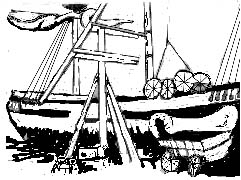 I. The Campaign
I. The Campaign
In this world, King George imposed his will upon parliament and Britain has never made peace with the colonies. The focus of the war has now shifted to other areas of the globe as well as to the frontiers of America. With the shift in strategies, the Ohio territory has now become the important sector to both sides. The British, for their part, now sought to check the expansion of the colonies throughout the Ohio territory by making alliances with the native tribes and building fortifications along the major waterways. [1]
Two of these new fortifications were now causing great concern to the Allied forces. The building of Fort Junadot and Fort Sandosky along the coast of Lake Erie showed a renewed British interest in controlling the trade in the Ohio territiory (see map 1). Situated along either side of mouth of the Sandosky River as it entered into Lake Erie, these two fortifications could control all the waterborne traffic seeking to reach the extensive waterways of central Ohio. The Allies saw this as a great threat the expanding American population seeking to trade with the east. [2]
Consequently, the Allied leadership put into action a plan to reduce these fortifications and bring the territory under Allied control. Major General Henry Knox (a distant and, some sources say, dubious relation to the more famous General Knox of the same period) was chosen to lead a mixed force of French and Americans into the Ohio Territory to take the two forts from the British.
Knox, though personally daring and disciplined, had never commanded a force larger the a few hundred men. His poor efficiency in leading a larger army was to prove disastrous for his army in the coming campaign. [3]
The Allied force consisted of:
- (1) two regiments of veteran French regulars (600 men) and one battery of heavy French siege guns, [4] all under an experienced, efficient and aggressive Brigadier General, the Count de Liqueur, an ardent believer in the American cause;
(2) three regiments of untried Continentals (900 men); four companies of veteran Continental Rifleman (240 men), one regiment of hastily organized Ohio militia (300 men) and one battery of Continental artillery (light guns), all commanded by John Q. Colonial, a man who had shown distinct brilliance for defensive actions and a thoroughly disciplined style of leadership.
Opposing Knox and his invading forces were British and provincial troops commanded by Major General, Sir William Youngerson. [5] Youngerson was efficient and disciplined. However, like many other English generals of his day, he was a cautious commander. His force consisted of:
- (1) battalion of Hessian grenadiers (240 men), two companies of German
yaegers (120 men), and a battery of Hessian artillery (light guns), under a brilliant but brutal professional soldier named [6] Brigadier General Verner Von Haight
(2) a battalion of British grenadiers (300 men), the 31st Regiment of Foot (300 men), a battalion of Canadian Provincial Highlanders (300 men), and a battery of Royal Artillery (light guns), under Brigadier General John Hazelthorne, a charismatic, disciplined, and efficient commander, who had spent all his career on the American frontier;
(3) one warband of Eastern Indians (240 warriors) under an excellent, aggressive but not always popular, Chief La Beouf.
In early spring, Knox gathered his forces on the Pennsylvania frontier at Fort Pitt and moved north to the shores of Lake Erie at Presque Isle. Here, Knox began to build boats. He built big boats, little boats, flat bottom boats and sail boats to transport the army from Presque Isle to the mouth of the Sandosky River. [7] Delays were inevitable that far away from a large depot and the construction of the flotilla took weeks longer than planned.
Finally in late summer, Knox boarded his army and moved west along the lakeshore. The passage west went quickly and Knox's army descended on their first objective, Fort Sandosky with unexpected speed. The British seemed to be completely unaware of the approach of the Allied army. Heartened by the good going, Knox proposed an immediate all out assault. However, all of his senior commanders advised caution. They argued the forts were too well laid out and defended to chance an all out assault. [8] An alternative plan was put forward which involved a move to a strong defensive position to await the arrival of the British field army. Then, when the British were defeated, the forts could be reduced at will. But Knox would have none of it and ordered the attack.
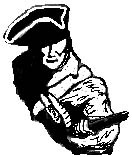
II. The Attack on Fort Junadot
Fort Junadot was selected for the first assault. The Allied army paraded before dawn and throughout the morning made several brave but fruitless assaults over the man-made obstacles surrounding the fort. The action was over well before noon. The Allied army had suffered severe casualties and never came close to scaling the walls. In fact, the casualties were severe enough for Knox to order a retreat east along the shoreline to considered his next move. However, events would not leave him long in contemplation.
While the Allies had been making their way west to Fort Junadot, the British army was gathering to the north at Fort Detroit. General Sir William Youngerson had planned to move his base of operations farther east along lake Erie, as a general plan to gain more control of the Ohio territory. A significant part of this plan involved the building of gunboats to gain naval superiority on the lake. This plan was well under way when word came of the Allied advance. Youngerson, showing uncharacteristic energy and dash, accelerated his plans and moved upon the enemy by amphibious means.
Youngerson packed his whole force on to any type of transport he could find, and protected by Royal Navy gunboats, quickly made the passage to the mouth of the Sandosky River. It was here that the Royal Navy was to strike the first blow.
Sailing ahead of the British army, Royal Navy gunboats, [9] under Lt. Commander Algernon Chartwell, slipped in among the boats of the Allied army destroying dozens of boats and burning a large amounts of supplies before being driven off by hastily positioned Allied field guns. Lt. Chartwell wrote in his report to the Admiralty: "We separated from the main squadron well before midnight so as to be in position to attack before dawn. The Rebels seemed to have made no preparations for any attack from seaward. With muffled oars, we were among their craft, many still laden with supplies, before they could react. Some 40-50 various small craft were sunk or burned before they brought up some guns and we were obliged to withdraw. Lt. Mound was killed by one of the initial salvos."
Without his main source of supply and transportation, Knox was forced to retreat eastward across dry land. Spiking all their field their guns and burning their baggage, the Allied army began making its way through small forests paths and along the lakeshore. Lt. Commander Chartwell and his boats followed close behind until they were joined by the flotilla carrying the rest of the British army.
At his first opportunity, Youngerson landed his British forces in an attempt cut off the retreat of the tiring Allied army. However, harassed every step along the way by Chief La Beouf's warband, Knox was able to slip around the British forces and find a solid defensive position farther to the east.
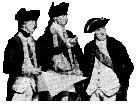
III. The Battle of Lake Erie Dunes
The decision by Knox to fight was based in part on the strength of the position he was able to occupy and in part on the exhaustion of his troops. His troops could simply not go on being battered and harassed and still remain an army. It was Knox's intention to fight from a good position, give the British an enough of a thrashing to check their pursuit, and then continue the retreat.
With that in mind, he set about positioning his troops. In the center, upon a pair of gradually rising, sparsely-wooded, sandy hills, he placed his Continental units under John Q. Colonial. The main body of the Continentals were stationed behind the crests of the hills to conceal their decimated ranks and protect them from the fire of the Royal Artillery. On the front side of the hills, Knox placed his four companies of rifleman in skirmish order to delay the enemy. On his right among the dunes along the lakeshore, Knox placed Count DeLiqueur and his French units. The French, as still the most disciplined of Knox's units, were given orders to attack if necessary to relief any pressure put upon the center enemy. On the extreme left, among the thicker vegetation of the forest, Knox placed the Ohio militia in skirmish to protect his flanks.
On the opposite side, Youngerson concentrated his strength in the center. The 31st Foote and the Royal Canadian Highland Militia, supported by the Grenadiers and Royal Artillery, advanced upon the Continentals. In the forest opposite the Ohio militia, Youngerson sent Chief La Beouf and his warriors in skirmish order. The Hessians were given the assignment of attacking the French among the dunes on the lakeshore.
The battle opened on the left. The Hessians operating under the general order of advance met the attacking French half way across the dunes. A murderous firefight ensued with the French regiments finally being forced to give way after the Hessian artillery battery unlimbered and began firing point blank. The French retreat became a rout under pressure supplied by the Yaeger companies and they moved to the edge of the battlefield. However, they had sufficiently bloodied the nose of the Hessian troops to make any further pursuit by the main body impossible and the Hessian commander settled for possession of the field. [10]
On the right, Chief La Beouf led his warriors into contact with the waiting Ohio militia. Youngerson had asked La Beouf to work his way through the forest and around the flank of the Allied army. [11] However, the Ohio militia was to prove well-suited to their role of blocking this move. The militia commander spread his men out in skirmish order and a see-saw battle began up and down the length of forest. The two units grappled with each other until sheer exhaustion brought a halt to the fighting. Chief La Beouf was to later try to form his warriors into some kind of order for one last attack, but was unsuccessful.
Youngerson, himself, oversaw the fighting in the center. The battle opened with a bombardment by the Royal Artillery. This was largely ineffective due to the extremely sandy soil of the hills upon which the Allies were situated. The cannonballs fired by the artillery simply stuck into the soil instead of skidding across the ground to cause casualties. After a half an hour of firing, the Royal Artillery limbered and prepared to follow the infantry.
The 31st Foote and the Royal Canadian Highlanders led the assault with the Grenadiers in reserve. From the outset, the passage up the sparsely wooded hill was contested by the Continental Rifleman. Firing from behind every piece of cover available, these expert marksman took a heavy toll on these advancing regiments. Several attempts to reach the crest of the hill were made only to stall under the withering fire of the rifle companies. The enthusiasm of the advancing regiments was further dampened by the fact that many of the Continental troops were dressed in hunting shirts exactly like the rifleman. This gave the British troops the impression the number of rifle armed troops was greater than it was. This was an idea all American commanders sought to foster throughout the war. [12] To a large extent this bit of propaganda was effective in this campaign. Captain Joseph Pierce-White of the 31st Foote was to write in his diary about the action on the day: "On the way up that bloody hill, the Rebel marksman hid behind every stump and bush and kept up a killing fire upon our ranks.....and we could see farther up upon the crest of the hill more of those devil riflemen."
Finally, Youngerson ordered the commander of the British troops, General Hazelthorne, to rally the lead regiments. The arrival of the charismatic General Hazelthorne, did little to boost the spirits of the men. However, his admonitions were to win them over and they moved off toward the enemy. Hazelthorne took the lead and the 31st Foote followed by the Royal Canadian Highland Militia swept up the hill pushing the Continental Rifle companies before them until they reached the crest of the hill. Upon the crest, a brief firefight ensued until the Continental regiments broke and ran for the forest behind their position. The only Allied troops which remained to cover the route were the steady Continental Rifle companies. Hazelthorne, attempting to follow up his success, continued to ride out of his troops exhorting them to keep moving, but a rifle bullet knocked him from the saddle. He was killed almost instantly and with him the momentum of the advance died as well.
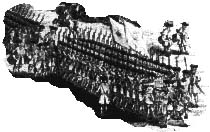
IV. Aftermath and Conclusion
The death of Sir John Hazelthorne was the last act in battle of Lake Erie Dunes. Knox, for his part, was unable to collect any of his routing troops together until several days later and many miles farther east. Only about one-quarter of the original Allied army was able to reach safety at Fort Pitt weeks later. Considerable confusion was to be exhibited by Allied leadership for some months after. The Allied defeat left the growing American population in the Ohio territiory without organized protection from any hostile forces.
Sir Youngerson contented himself with possession of the battlefield. His troops had been on the move for many days and were exhausted. However, as a result of his victory, the British were now free to consolidate the gains in the territory. He was to receive a peerage shortly after the battle.
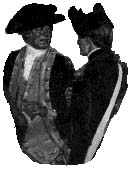
V. Coming Soon
The American population organizes militia units to fend off attacks by Chief La Beouf and his warriors. They are successful enough to force Lord Youngerson to put troops in the field.
Notes:
[1] This history is the first in a set of fictional campaigns created and carried by the author with the help of solo component of Computer Strategies Pty. Ltd software. Ohio was chosen as a theater of war simply because the author lives there. Future campaigns will include War of 1812, French and Indian War, and Civil War.
[2] The author disclaims any pretense to historical accuracy, strategic expertise or even common sense in the setting of the background and parameters of this campaign.
[3] The attributes given each commander are those called for by the computer
program running the campaign and battle sequences. The author would like to thank his wife for randomly picking out each attribute.
[4] The original plan, as stated in the unpublished diary of Henry Knox the Younger, was to have a swift moving all-American force. However, the French would have none of that and insisted that a French force be included and remain under French command.
[5] Sir William Youngerson was the youngest of thirteen sons of an obscure
country squire and until he received his knighthood after a particularly brutal action in the West Indies, the greatest accomplishment of his life was being the only child to have survived bouts with drink, gambling, wronged husbands, and local politics (local politics being the most deadly). He was, however, a forward-thinking student of his profession and well suited to his frontier assignment.
[6] Von Haight is named for the authors Tax Law professor who shares many of
the same qualities.
[7] It should be noted that gunboats are one type of boat missing from this list. Through faulty intelligence, Knox firmly believed the British were not building developing any naval power upon the lake. This was a conclusion which would cost his army dearly. Although, his decision may have also been forced upon him because of the lack of ordinance to put into these boats. Promised by Congress, the needed guns and supplies never arrived.
[8] Well positioned on high ground, Fort Junadot and Fort Sandosky were
defended by His Majesty's 52nd Foote and recently installed heavy guns manned by experienced Royal Navy personnel. The land approaches afforded no cover, making an assault of the fort a risky proposition.
[9] These were the same gunboats which General Knox had been assured did notexist by his informants.
[10] The Hessians did not know the true status of the French until later or they may have made more of an effort to pursue. French wounded and prisoners would later tell how decimated and fatigued the French really were before the battle. Both regiments were down to half strength. Had the Hessians known this, they perhaps would have been more aggressive.
[11] Chief La Beouf raised on the edge of European settlements had received
an education from white schools. However, his hatred for the expanding colonial settlements were sealed at a young age when the villages of his people were attacked to make for the expansion of the frontier.
[12] Hofstadter, "America as a Gun Culture," p. 10.
Back to The Herald 23 Table of Contents
Back to The Herald List of Issues
Back to MagWeb Master Magazine List
© Copyright 1998 by HMGS-GL.
This article appears in MagWeb.com (Magazine Web) on the Internet World Wide Web. Other articles from military history and related magazines are available at http://www.magweb.com